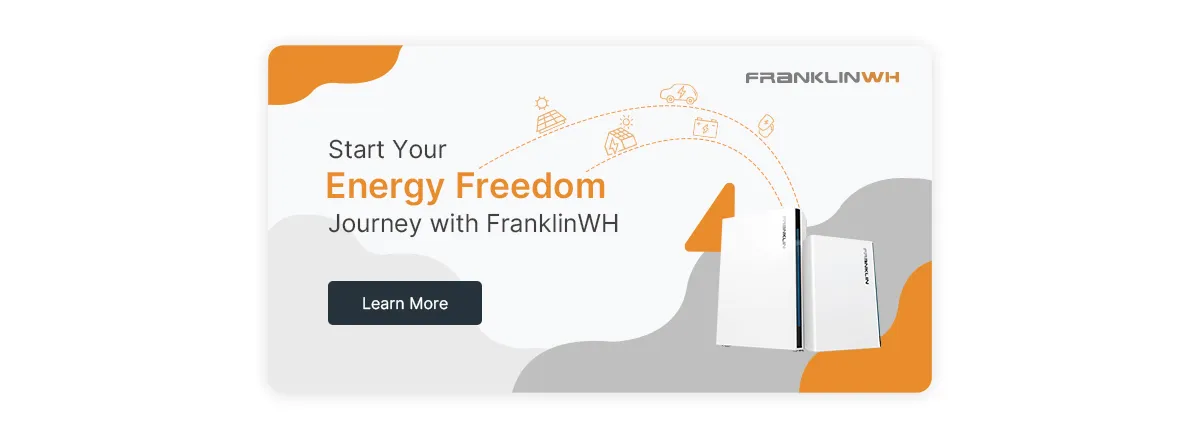Introduction
Solar energy production in the home is here to stay. In 2022, solar energy accounts for 4.94% of US electrical output. Around 3.2% of US single-family detached homes have installed solar panels. This shows the growing acceptance of technology. However, solar alone is not the optimal solution for a home. For instance, in many jurisdictions, a solar system connected to the main panel must be shut down when there is a power outage. This is one way in which battery storage can help.
In this article, we will consider home solar, battery storage, and some simple battery sizing information to better power a home.
Follow closely.
Whole Home Solar: How it works
Solar panels are multiple photovoltaic (PV) panels. These panels are made up of many solar cells, typically within a string of 60-72 cells. A solar installation can provide enough power to supply a home’s energy needs.
Multiple solar panels, usually around 15-25, are wired into a solar array. The array can be installed anywhere around the house as long as there is no obstruction to sunlight.
When sunlight hits the panels, the solar cells convert the sun's photons into electricity.
However, the PV system only generates direct current (DC), while home appliances are generally designed to use Alternating Current (AC).
Therefore, an inverter is used to convert the DC to AC to power home appliances. The inverter feeds AC power to your home's main panel at the appropriate voltage to serve the electrical loads in your house.
The inverter can be a large central box for all solar panels. It can also be a small micro-inverter attached to each solar panel to perform the AC-DC conversion.
Note that, where utility regulations allow, when you generate more solar energy than your total home electrical loads, you can sell the excess energy to the electric utility via your utility meter. If this is not allowed, that energy is lost without battery storage.
The Solar with battery storage
Your solar panels can only function when the sun is shining.
However, using battery storage, you can leverage the excess energy generated by your solar panels. You can use the energy at any time, even when there is no sunlight, increasing the efficiency and return on investment (ROI) of your solar system.
There are four different types of batteries used with solar. These are:
- Lithium-ion batteries: These batteries are lightweight, smaller, and more efficient. They don't need to be fully charged before using them. These batteries have a round-trip energy efficiency of 95-98%. They have a low charging cycle, which could be as low as two hours. Also, they have a low self-discharge rate. However, if not properly installed, earlier types of lithium-ion batteries are highly flammable. Modern lithium-iron phosphate batteries are far safer. They are more expensive but reliable and require less maintenance than other battery types.
- Lead-Acid batteries: These are the oldest type of rechargeable battery. They are quite heavy and charge slowly. They can only hold minimal energy per kg of weight. They are quite cost-effective and a popular choice for solar batteries. However, lead-acid batteries have a short cycle life of 200-300 discharge charge cycles. They only last about half as long as lithium-ion batteries.
- The Nickel Cadmium batteries: Nickel-cadmium batteries are made of nickel oxide hydroxide and metallic cadmium. They are not commonly used for household solar. They can tolerate extreme temperatures of 120°F - 160°F. They can function at extreme temperatures; so, they are mostly used in the industrial and airline sectors. Nickel Cadmium batteries require minimal maintenance and have a long life cycle (2000-2500 cycles). Also, they have a high energy density of around 50-75 Wh/kg.
- Flow batteries: They rely on chemical reactions. The flowing of liquid-containing electrolytes between two chambers within the battery produces energy.
To store a large quantity of energy, the tanks containing the electrolyte liquid must be large. So, flow batteries are quite costly.
How many solar batteries do you need for your solar?
This depends on why you are using solar and how much energy you use. One consideration is continuous load versus surge load. When a home device is turned on, it can demand a much higher power supply than when operating, for only a small period of time. System planning includes identifying all of your home loads and both continuous and surge demands.
If you intend to use your solar system to power energy-consuming gadgets, you need a highly durable battery. For example, if you consume around 0.75-1KW energy per hour, you can use a 13 kWh battery for 13-16 hours. In this instance, a 10 kWh battery would last for only 10-12 hours during a grid outage. However, starting a high-demand device such as an air conditioner or pool pump could create too high a demand for a single battery.
If you intend to go off-grid, you will need an even higher storage capacity because that extra power source isn’t available when solar isn’t producing sufficient energy.
Conclusion
To maximize the use of your solar installation, you need to get quality home battery storage. With or without sunlight, the solar and battery keep your household up and running.



